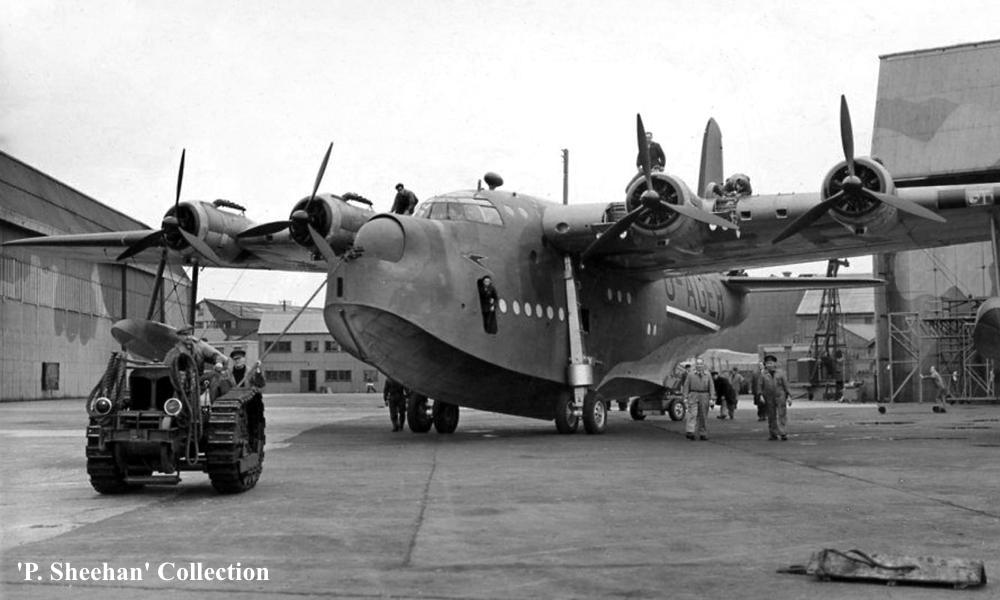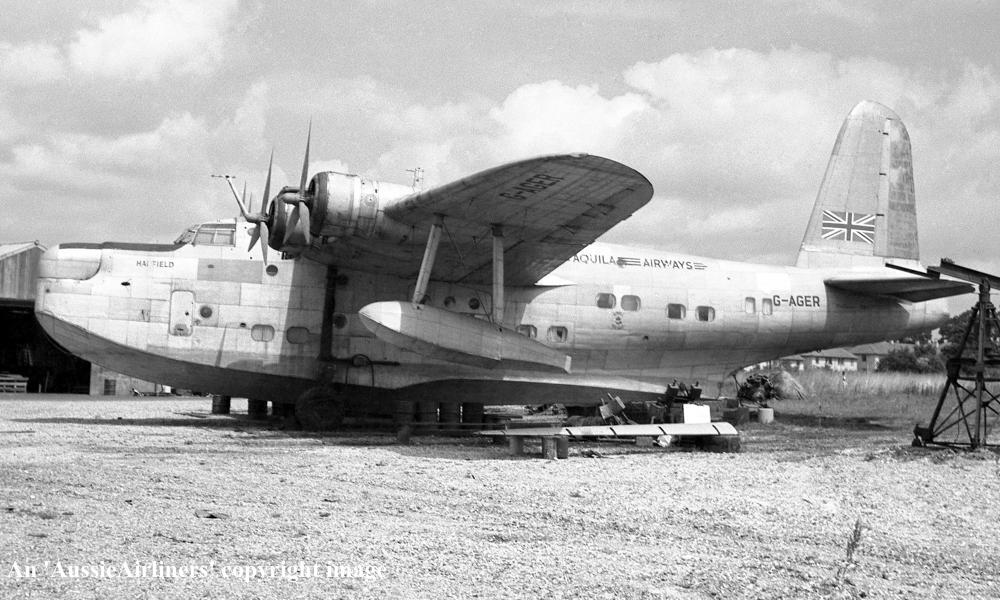G-AGER. Short S-25 Sunderland Mk III (Hythe). c/n JM660. |
This aircraft was built by Short Bros. Ltd at Rochester, Kent as a Sunderland Mk III - 1942 It was built for the Ministry of Supply under Contract B.78939/40 It was the 1st aircraft built for BOAC by Short Bros under this contract Contrary to popular belief the Sunderlands built for BOAC were not converted from existing military aircraft They were built new as civil aircraft without any armament or military equipment at all Entered onto the British Aircraft Register as G-AGER (CofR 9374/1) - November 12, 1942 Registered to British Overseas Airways Corporation (BOAC), Clifton, Bristol, England (Bristol was the location of BOAC Headquarters during World War 2) It was allocated the name 'Scarborough' but it was not taken up Powered by Bristol Pegasus XVIII engines of 815 hp each First flown at Rochester, Kent - December 26, 1942 The aircraft was under the command of John Lankester Parker (Short Bros Senior Test Pilot) The aircraft was delivered to BOAC at Hythe - January 08, 1943 It was the first Short S-25 Sunderland Mk III delivered to BOAC It was closely followed by a further 5 examples (G-AGES - G-AGEW) forming the initial batch of 6 aircraft Certificate of Airworthiness (CofA #6955) issued - January 26, 1943 Initially the aircraft were painted in a dark green / grey camouflage livery with very large black registration markings on the rear fuselage, outlined in silver and underlined with a red, white and blue stripe This clearly identified them as being British civil aircraft Entered service operating the Poole - Lagos service via West Africa as 'Service Number 19W179' - March 26, 1943 The BOAC Sunderland Mk IIIs were replaced on the West Africa route by land planes - October 1943 This aircraft was redeployed on the England - Karachi service - October 25, 1943 As these aircraft had to pass through the active military zones in North Africa enroute to Karachi, their civil registrations were temporarily exchanged for 'military roundels and codes' in the 'OQZA' to 'OQZZ' band This aircraft was allocated the military code 'OQZR' It is believed that all 'Hythe' aircraft had their Transport Command call signs allocated on September 23, 1943 These codes were quickly applied to the rear fuselage in place of their current civil registration marks Both aircraft and flight crews were temporarily transferred to the jurisdiction of RAF Transport Command but the individual aircraft were still owned by BOAC and were operated by BOAC employed crews The callsigns identified each aircraft as follows: The letter 'Q' identified the aircraft as being operated by BOAC; The letter 'Z' identified the aircraft as being a Short Sunderland Mk III; The last letter identified the individual aircraft With the end of European hostilities the aircraft reverted to civilian status - camouflage and military codes were removed BOAC commenced an upgrade and modernisation program to 18 of their 24 passenger carrying Sunderland aircraft - January 1945 The aircraft type was named the BOAC 'Hythe' Class flying boat Each of the converted aircraft in the fleet was allocated a name starting with the letter 'H' This aircraft - G-AGER - was named 'Hadfield' The upgrade on this particular aircraft was carried out in stages between April and July 1945 The first stage involved the fitting of 16 new passenger seats on the main deck (H1) The second stage involved the addition of either a 'C' class' type promenade deck (H2) or the addition of a further 8 seats (H3) - giving a total accommodation for 24 passengers The individual aircraft that were upgraded with either the 'promenade deck' or the extra 8 seats are unknown In addition to the London - Karachi terminating service, BOAC introduced a new 'Hythe' Class service in conjunction with Qantas Empire Airways (QEA) on the England - Australia route - May 12, 1946 This route: Poole - Marseilles - Augusta - Cairo - Basra - Bahrein - Karachi - Calcutta - Rangoon (now Yangon) - Singapore - Sourabaya - Darwin - Bowen - Sydney took on average eight days to complete the entire journey 'Hadfield' departed Poole on its first eastbound flight to Sydney (Australia) as a 'special flight' - July 22, 1946 It arrived at Sydney (Rose Bay) having completed its first 'eastbound' flight - July 29, 1946 The aircraft were operated by BOAC crews from Poole to Singapore return The Singapore - Sydney return sectors were crewed by a Qantas Empire Airways' crew Many of these QEA crew members were seconded from the R.A.A.F. due to post-war shortage of QEA employees Many pilots who had been seconded to QEA in this manner converted their secondment to full-time employment, thus forging new and permanent careers with the airline 'Hadfield' was badly damaged when it skidded whilst alighting at Calcutta - October 18, 1946 The starboard wing-tip, float and struts were damaged It was repaired 'on-site' and returned to service - December 06, 1946 The BOAC flying boat base was relocated from Poole to Hythe (Southampton Water) - April 01, 1948 'Hadfield' was withdrawn from service and stored at Hamble (England) - December 03, 1948 Registered to Aquila Airways Limited, London (CofR R2541/2) - December 06, 1948 The aircraft retained the name 'Hadfield' whilst operated by Aquila Airways Aquila Airways operated services from Southampton to Funchal (Island of Madeira); Lisbon (Portugal); Montreux (south eastern shore of Lake Leman, Switzerland); Las Palmas (Canary Islands) This aircraft was utilised to transport film crews who were making the 'Moby Dick' movie, which was partially filmed at Madeira and Las Palmas (Canary Islands) When its CofA expired it was withdrawn from service and stored at Hamble (England) - July 19, 1955 Broken-up for scrap at Hamble (England) - July 1956 Cancelled from the British Aircraft Register - July 26, 1956 |
 |
G-AGER. British Overseas Airways Corporation - 'Hadfield' in the war-time 'camouflage' livery at Hythe, circa 1943. (P. Sheehan Collection Copyright Image 2545-993.) |
 |
G-AGER. Aquila Airways Limited - 'Hadfield' in the standard livery at Hamble, circa 1955. (A. J. Jackson Collection Copyright Image 2545-970.) |